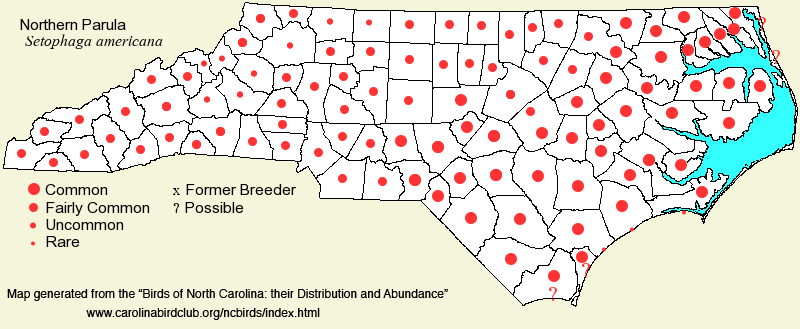 |  |
|
Northern Parula - Setophaga americana PARULIDAE Members: | Search Common: Search Scientific: |
|
|
|||||||
| General Comments | The Northern Parula is a bird saddled with an awful common name, and this is even more so now that it and its close cousin, the Tropical Parula, are no longer in their small genus (Parula). They have now (in 2011) been dumped into the very large genus that was formerly Dendroica, but is now Setophaga. All these other Setophaga species except American Redstart have the last name as "warbler". At least, the species has not been lumped or split, so maybe it doesn't matter what its name is, other than how people pronounce "Parula". This species nests over nearly all of the eastern United States and Canada, and not surprisingly it nests in all parts of North Carolina. In the state it favors swamps and bottomlands, especially where Spanish Moss or Usnea lichen (old man's-beard) are common (for nest placement). Away from such habitats, it occurs in other moist forests and woodlands, such as cove forests; occasionally it does nest in drier forests, as long as one of these plants is present. Most Northern Parulas winter south of the United States, though there are a handful of state records of early winter stragglers. | ||||||
| Breeding Status | Breeder | ||||||
| NC BRC List | Definitive | ||||||
| State Status | |||||||
| U.S. Status | |||||||
| State Rank | S5B | ||||||
| Global Rank | G5 | ||||||
| Coastal Plain | Summer resident. Over most of the region -- common, to very common in several of the larger river floodplains; however, uncommon to fairly common in large nonriverine forests, and apparently absent at Buxton Woods near Cape Hatteras. Very rare straggler into early winter, mainly along the coast; at least 24 records from mid-Dec to early Jan, mostly on coastal (or Mattamuskeet NWR) CBC's. Quite notable for the latter half of winter was a photographed bird that visited a feeder in Vass (Moore) from 17 Jan - 27 Feb 2015 [Chat 79:104 link]; a few others near the coast have been reported in recent years in late Jan and Feb. Mainly late Mar (and now arriving often by mid-Mar) to mid-Oct. Peak counts: | ||||||
| Piedmont | Summer resident, with noticeable migratory movements. In summer, fairly common over most of the province, but common in some wide floodplains, such as along the Cape Fear River system and around Falls and Jordan lakes. Uncommon in much of the western half of the province, as suitable habitat is locally scarce. Can be common at times in migration. Mainly late Mar to mid-Oct, casual to now very rare to mid-Jan (mostly in the eastern portions -- at least 14 records after mid-Dec). One on the UNC campus in Chapel Hill, 26 Dec 2016 and again 10-25 Feb 2017 almost certainly overwintered, a likely first for the province. Another essentially over-wintered at a feeder in Raleigh, 30 Dec 2019 - 31 Jan 2020. Another definitely over-wintered at a feeder in Chatham from 30 Dec 2023 - 27 Feb 2024. Peak counts: | ||||||
| Mountains | Summer resident, with noticeable migratory movements. Uncommon to fairly common at lower to middle elevations, up to about 5,200 feet. Fairly common to common in migration. Mainly early Apr to mid-Oct. No winter reports. Peak counts: | ||||||
| Finding Tips |
It is hard to miss in the Coastal Plain in spring or summer if birding close to rivers, such as the Roanoke, Neuse, or Lumber. **** | ||||||
| Attribution | LeGrand[2025-05-09], LeGrand[2024-05-15], LeGrand[2023-04-07] | ||||||
| NC Map Map depicts all counties with a report (transient or resident) for the species. | Click on county for list of all known species. |
| NC Breeding Season Map Map depicts assumed breeding season abundance for the species. |  |